MARK BANDO'S WEBSITE
UNCLE BOB
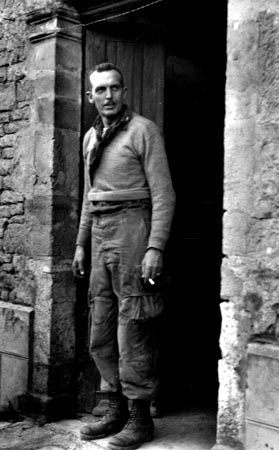 Born 3 April, 1905, Colonel Robert Sink commanded the 503rd Parachute Infantry Battalion before taking command of the newly forming 506th PIR. A product of West Point 1927, Sink served in Puerto Rico, Ft Meade, MD, Fort McKinley, Phillipine Islands,
and Ft Huachuca, AZ. before joining the Airborne. Colonel Sink had an unusual command style, and won over his troops by caring about them, rather than by strict discipline. His sense of humor was well known. When (mildly) exasperated, he would mash his overseas cap against his scalp and rub it around in circles. When highly exasperated, he would remove his cap and slam it onto the ground. Sink was also capable of playing the martinet, as evidenced by his ruthless drunmming out ceremony for those who failed to return from furlough after jump school.
Born 3 April, 1905, Colonel Robert Sink commanded the 503rd Parachute Infantry Battalion before taking command of the newly forming 506th PIR. A product of West Point 1927, Sink served in Puerto Rico, Ft Meade, MD, Fort McKinley, Phillipine Islands,
and Ft Huachuca, AZ. before joining the Airborne. Colonel Sink had an unusual command style, and won over his troops by caring about them, rather than by strict discipline. His sense of humor was well known. When (mildly) exasperated, he would mash his overseas cap against his scalp and rub it around in circles. When highly exasperated, he would remove his cap and slam it onto the ground. Sink was also capable of playing the martinet, as evidenced by his ruthless drunmming out ceremony for those who failed to return from furlough after jump school.
The photo above, taken 8 June, 1944 in Normandy, shows Sink in the door of his 2nd Command Post in France. This was a farm in Angoville, just south of the church. When not on an actual combat mission, Sink rarely wore jump boots. Sink also reached the General ranks in postwar years. He was the only original regimental commander in the 101st to remain in command through the entire existence of his regiment. photo c/o J. Reeder
Sky Jackson

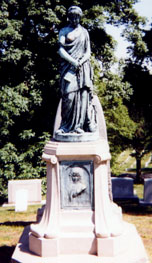 Schuyler "Sky" Jackson was a member of the H&H 502 DEMO platoon, from 1943-45. Sky is among those pictured in the famous group shot of Ike talking to Lt Strobel at Greenham Common before D-Day. He served as bodyguard to Colonel Moseley after finding him with a broken leg in Normandy, and was later decorated for patrol work beyond Carentan. Sky was on a patrol with Item Co. near Dodewaard, the day the tragic mine accident claimed the lives of many of his buddies. On Christmas morning, 1944, Sky hit 2 German tanks with his bazooka, knocking one of them out. Of combat he used to say: "I ate it up!" Sky was awarded the Silver Star for his Christmas day exploit.
Schuyler "Sky" Jackson was a member of the H&H 502 DEMO platoon, from 1943-45. Sky is among those pictured in the famous group shot of Ike talking to Lt Strobel at Greenham Common before D-Day. He served as bodyguard to Colonel Moseley after finding him with a broken leg in Normandy, and was later decorated for patrol work beyond Carentan. Sky was on a patrol with Item Co. near Dodewaard, the day the tragic mine accident claimed the lives of many of his buddies. On Christmas morning, 1944, Sky hit 2 German tanks with his bazooka, knocking one of them out. Of combat he used to say: "I ate it up!" Sky was awarded the Silver Star for his Christmas day exploit.
In postwar years, Sky Jackson was preeminent in the 101st Assn as a member of the Board of Governors and was always along on return visits to Carentan and various parts of Holland. He was especially fond of the Dutch people.
After WW2, Sky owned and operated a gas/service station in Bethesda, MD. I first met Sky in 1971. I learned that he was tough and boisterous, but also very sensitive and sentimental. He was always kind and helpful to my research efforts.
Chappie Hall, the former Protestant Chaplain of the Deuce, used to call Sky "Screwler" or the "BHOB" (Bald Headed Old Bastard), and Sky was frequently mentioned in Chappie's publication the 502 Ducksheet. Sky passed on about ten years ago, but I'll never forget the night in 1989, when I saw him leading everyone in song at a bar in Isigny, France. Sky knew every stanza of 'Roll me Over in the Clover', as well as many stanzas that nobody had ever heard before. He sang them, with the crowd filling-in after each stanza with the chorus. Wish there was a videotape of that-it was pure magic.
The photo above right depicts a 'neigbor' in the cemetery where Schuyler is interred. Her exposed breast is shiny and smooth, as the apparent result of frequent fondling. A popular story is that Sky comes over to visit her each night.
Sky Jackson was loved by many and he is missed.
LTC James L. LaPradeA product of the famous West Point class of 1939 (Cole, Ewell, Kinnard, et al), LTC LaPrade joined the 101st ABD after Normandy and led 1st Bn 506th into Holland and Bastogne. He was KIA in his Command Post in Noville, Belgium by German artillery fire on 19 December, 1944.
Background: born May 4, 1914 at Kenedy, TX, LaPrade served in the ROTC, CMTC, Co.'C' 9th Inf. at Ft Sam Houston, also the 41st and 68th service squadrons at Kelly Field, TX, before entering the USMA July, 1935. After West Point but before joining the 101, LaPrade served in Co. G, 29th Inf (Benning), B/501 PIB, H&H 502 PIB, Academic Bn ISSU, EXO of ASPS, Airborne Command, where he became a leader in developing Airborne doctrine, Line officer of same, (all 1941-42 assignments), Detached Service to HQ AAF Materiel Center, EXO H&H 513th PIR, Bn C.O. 1st Bn 542nd PIB, Bn C.O. 1st Parachute Training Rgt, volunteered for combat duty overseas, EXO of replacement unit shipped to ETO, then Regtl S-4 of 506th before assignment to 1st Bn as C.O.
Kinnard called him "one of the best commanders I had during WW2." General McAuliffe called LaPrade "the finest battalion commander I had in the division." LaPrade's remains were re-interred at West Point in 1949. His wife Mary, who never re-married, passed on July 4th, 1999.
James LaPrade's brother, Lt Robert M. LaPrade was KIA with the Marines on Guadalcanal, winning the Navy Cross. After being wounded twice taking out a M.G. nest with his men, Lt LaPrade remained in command, directing his troops until he lost consciousness. Destroyer Escort DE-409 was named after him.
Hugh Mozley
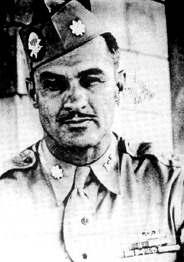 Colonel Hugh A. Mozley, distinguished WW2 commander of the 326th Airborne Engineer Bn, was born 29 June, 1909. A Bio of Mozley by Michel Detrez, follows: "Hugh Mozley began his military career in November 1940, as platoon leader and company commander in the 106th Engineeer Rgt, before volunteering for the Paratroops at the end of 1942. The 31 year old Captain had served as an instructor at the Engineer School at Ft Belvoir, VA. With past civilian experience in steel bridges and building construction, and a military engineer background, he was a logical choice for assignment to the newly activated 326th Airborne Engineer Bn. The 326th AEB had been activated in August, 1942, and was primarily comprised of men from the 82nd Division's 307AEB and the 327th GIR. Captain Mozley attended The Parachute School in late 1942 and became C.O. of Company 'C', originally the only jumping company of the 326th AEB. Mozley became battalion Executive Oficer in January, 1944, and was promoted to Major on June 1st.
Colonel Hugh A. Mozley, distinguished WW2 commander of the 326th Airborne Engineer Bn, was born 29 June, 1909. A Bio of Mozley by Michel Detrez, follows: "Hugh Mozley began his military career in November 1940, as platoon leader and company commander in the 106th Engineeer Rgt, before volunteering for the Paratroops at the end of 1942. The 31 year old Captain had served as an instructor at the Engineer School at Ft Belvoir, VA. With past civilian experience in steel bridges and building construction, and a military engineer background, he was a logical choice for assignment to the newly activated 326th Airborne Engineer Bn. The 326th AEB had been activated in August, 1942, and was primarily comprised of men from the 82nd Division's 307AEB and the 327th GIR. Captain Mozley attended The Parachute School in late 1942 and became C.O. of Company 'C', originally the only jumping company of the 326th AEB. Mozley became battalion Executive Oficer in January, 1944, and was promoted to Major on June 1st.
After the death of the original battalion commander, 28 year old LTC John C. Pappas on 13 June, 1944 (KIA in an ambush in Normandy), Mozley took over the 326th AEB for the duration of WW2. Pappas had been a rather unpopular commander, but Mozley was well-liked and respected by his troops. On 24 September, during the Holland campaign, Mozley received a promotion to Lieutenant-Colonel. He valiantly led the battalion to the end of the war, winning among his other decorations, the Officer of the Order of the Crown, a high Belgian distinction for leadership at Bastogne. After WW2, Mozley attained the rank of full Colonel and served as Airborne advisor to General MacArthur in Japan.
Webmaster's note: LTC Mozley was barrel-chested and fearless. I previously posted a story here, about an alleged fistfight between Mozley and an EM who was nicknamed 'Spiderlegs'. This story came from former C/326th troopers Skip Smith and Robert Likam. Since then, input from George 'Bird Legs' Dickson , also of Company 'C', has refuted that story.
a) there was no trooper nicknamed 'Spider Legs' in the 326th AEB.
b) Bird Legs says he wasn't dumb enough to fight his commanding officer, and no fight between himself and Mozley ever took place
c) Dickson was a formidible boxer and football player, and he did have a fistfight with Tom Betras(of later Joe Mann fame), while stationed near Evansville, Indiana. Early in that fight, a blow opened a cut over Betras' eye and the fight didn't last long. (Thanks to Mike Detrez, for the introduction to George Dickson).
Hugh Mozley survived to see the milennium and passed away on 21 January, 2000. photo c/o Hugh Mozley.
Big Cec
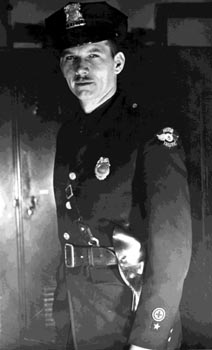 Cecil Lee Simmons was a policeman in Grand Rapids, MI before WW2.
He had already served in the National Guard and became a Federalized paratroop officer after the war broke out. Entering Normandy as a Captain in command of H/502, 'Big Cece'was later given command of Regimental HQ Company. He was soon promoted to Major, and returned to 3rd battalion as EXO. The 3rd battalion commander, LTC Cole had been killed and Major John P. Stopka had assumed command. On 14 January, 1945, Stopka was killed in the woods north of Bastogne and Simmons became the last commander of 3/502-the only 3rd battalion C.O. to survive WW2. After WW2, Simmons remained in the National Guard and attained the rank of Major General. During the 1967 'civil disturbance' in Detroit, Simmons commanded all Michigan Guard forces in supressing the Riot. photo courtesy Madge Simmons.
Cecil Lee Simmons was a policeman in Grand Rapids, MI before WW2.
He had already served in the National Guard and became a Federalized paratroop officer after the war broke out. Entering Normandy as a Captain in command of H/502, 'Big Cece'was later given command of Regimental HQ Company. He was soon promoted to Major, and returned to 3rd battalion as EXO. The 3rd battalion commander, LTC Cole had been killed and Major John P. Stopka had assumed command. On 14 January, 1945, Stopka was killed in the woods north of Bastogne and Simmons became the last commander of 3/502-the only 3rd battalion C.O. to survive WW2. After WW2, Simmons remained in the National Guard and attained the rank of Major General. During the 1967 'civil disturbance' in Detroit, Simmons commanded all Michigan Guard forces in supressing the Riot. photo courtesy Madge Simmons.
Robert Harwick
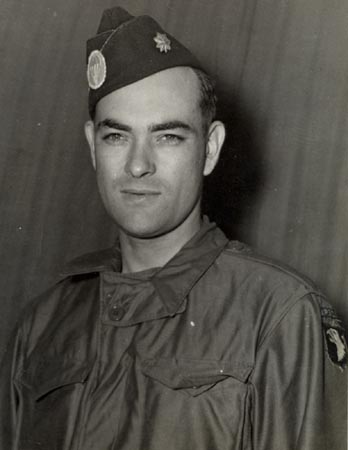 Bob Harwick entered Normandy as company commander (Captain) of Company 'H', 3/506th. He was captured near Dead Man's Corner and
soon managed to escape during the chaos of a night artillery barrage provided by the U.S. Navy. Re-equipping himself with discarded weapons and accoutrements which he found along the road, he rejoined the remnants of Third Bn. He found he was the only surviving company commander in that Bn. He was made acting Bn. commander , but his command of 3rd battalion was only temporary. During the battle of Bastogne, LTC LaPrade was KIA at Noville, Belgium and Harwick assumed command of 1st Bn, 506th. He was seriously wounded by shell fragments on 9 January, 1945.
Bob Harwick entered Normandy as company commander (Captain) of Company 'H', 3/506th. He was captured near Dead Man's Corner and
soon managed to escape during the chaos of a night artillery barrage provided by the U.S. Navy. Re-equipping himself with discarded weapons and accoutrements which he found along the road, he rejoined the remnants of Third Bn. He found he was the only surviving company commander in that Bn. He was made acting Bn. commander , but his command of 3rd battalion was only temporary. During the battle of Bastogne, LTC LaPrade was KIA at Noville, Belgium and Harwick assumed command of 1st Bn, 506th. He was seriously wounded by shell fragments on 9 January, 1945.
After WW2 Bob Harwick was a business executive, but he died in the early 1960s, of a heart attack, while attending a conference.
U.S. Army photo courtesy Nadine Wierzbowski collection.
Lt Jack F. Dulaney, I/502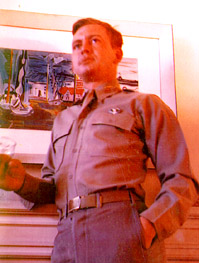 Born in Mississippi, but raised in the Great Smokey Mountains of Tennessee, Jack Dulaney was an inter-collegiate light heavyweight boxer. His father died from wounds received in WWI. Jack attended the USMA at West Point and graduated in January, 1943, with George Eberle, (who also joined the 502 PIR). He joined the 101st Airborne in England in early 1944 and was made a platoon leader in Company 'I' 3rd Bn, 502 PIR, under LTC Robert Cole.
Born in Mississippi, but raised in the Great Smokey Mountains of Tennessee, Jack Dulaney was an inter-collegiate light heavyweight boxer. His father died from wounds received in WWI. Jack attended the USMA at West Point and graduated in January, 1943, with George Eberle, (who also joined the 502 PIR). He joined the 101st Airborne in England in early 1944 and was made a platoon leader in Company 'I' 3rd Bn, 502 PIR, under LTC Robert Cole.
In Normandy, Lt Dulaney received a through and through bullet wound to the upper arm, but refused evacuation. On 8 June, 1944, near Houesville, France, he received a suicidal order from LTC Cole to lead his platoon in an attack across open ground toward three MG42 positions which were cross-firing.
Lt Dulaney told his men that he was going to charge the nearest German MG position by himself, and: "There's not a damn man to follow, unless I make it." Dulaney charged across the exposed ground and about 2/3 of the way across the field was struck down by German bullets. His platoon Sgt, Ralph Casas, ran out and flopped down beside the lieutenant. He placed him on his back and crawled back to safety with him. During this evacuation from the battlefield, the lieutenant was struck 2 or 3 more times by bullets. Lt Dulaney received the Purple Heart with oakleaf cluster, and the Silver Star, but his WW2 combat days were over.
As a result of his serious wounds, he spent three years in 5 different hospitals, and underwent 3 operations. He was retired as a captain of infantry with 100% disability. In 1947, he married Jerry Wolf. He returned to college and received an advanced degree in chemical engineering from the University of Tennessee. He had a long, successful career with the Allied Chemical and Dye Company. In the 1970's he changed careers and became an independent commodities broker. In the 1980's his wounds which had never completely healed, began to cause him severe problems and he died 12 May 1988 in Atlanta, GA, of blood poisoning, at the age of 67. Thanks to Claire Wolf and Allie Mae Beall (Cole) for the photo and the biographical information on Lt Dulaney.
John J.'Moe'Higgins, I/501 PIR
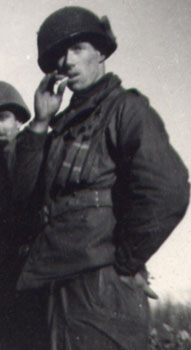
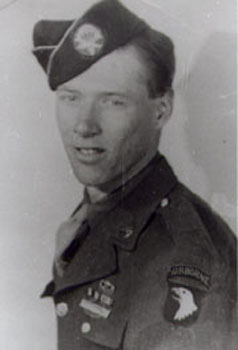 Moe Higgins of New Rochelle, NY, was an original member of I/501. He is not to be confused with 'Pinky' Higgins of the same company, from Detroit. Moe went with Item company from Camp Toccoa to Austria. In Normandy, he was misdropped below Carentan with Lt Robert Saum's stick, which was intended for Drop Zone 'C', (way up near Hiesville). Members of his stick made a precarious journey back to friendly lines which lasted a week. Moe survived the battles at Eerde, Holland and on the Island west of Arnhem. At Bastogne, he survived the costly battle of Wardin. By the time the above photo was made by friend Billy Ogle in Alsace, Moe had been through the wringer. He was a true combat veteran and survivor, whose stance, facial expresion and demeanor reflect his status. He wears M43's and is accustomed to never standing around with his hands in his pockets, even when smoking. His left hand is placed with the back side bent against his hip.
Moe Higgins of New Rochelle, NY, was an original member of I/501. He is not to be confused with 'Pinky' Higgins of the same company, from Detroit. Moe went with Item company from Camp Toccoa to Austria. In Normandy, he was misdropped below Carentan with Lt Robert Saum's stick, which was intended for Drop Zone 'C', (way up near Hiesville). Members of his stick made a precarious journey back to friendly lines which lasted a week. Moe survived the battles at Eerde, Holland and on the Island west of Arnhem. At Bastogne, he survived the costly battle of Wardin. By the time the above photo was made by friend Billy Ogle in Alsace, Moe had been through the wringer. He was a true combat veteran and survivor, whose stance, facial expresion and demeanor reflect his status. He wears M43's and is accustomed to never standing around with his hands in his pockets, even when smoking. His left hand is placed with the back side bent against his hip.
Pete Tessoff, a.k.a. 'The Mad Russian' was also a member of Item Company. He told me a funny story about a conversation he heard around VE-Day, between a new replacement 2d lieutenant, and Moe Higgins. The conversation was simple and went like this:
"What's your name, soldier?"
"Moe."
"What's your name, soldier?"
"Moe Higgins."
"What's your name, soldier?"
"Private Moe Higgins."
"What's your name, soldier?"
"Private Moe Higgins, SIR..."
Moe died recently in N.Y., and in postwar years, was well-known to the tavern keepers in
his neighborhood. This photo is one of my all time favorite 101st pics and gives a classic example that epitomizes the
post-Bastogne Screaming Eagle.
Sunny Fuhrer
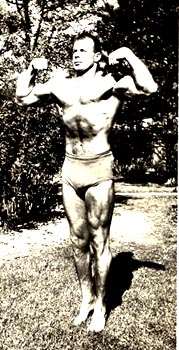 Sgt Sunday Feuer was a physical specimen. Originally assigned as an instructor at Ft Benning's TPS, he left to join the 501 regiment in spring, 1943. When Colonel H.R. Johnson took his men through jump training, he saw some instructors at The Parachute School, whom he considered outstanding. Johnson persuaded some of them to leave TPS and join his regiment at Camp Mackall, N.C. Besides Feuer, Johnson brought along Lt Howard Chappell(a.k.a.'Flash Gordon'), Lt Frank 'Foxy' Gregg,
Sgts Lou Henson, J.P.Knight, Euel Langlinais, and others.
Sgt Sunday Feuer was a physical specimen. Originally assigned as an instructor at Ft Benning's TPS, he left to join the 501 regiment in spring, 1943. When Colonel H.R. Johnson took his men through jump training, he saw some instructors at The Parachute School, whom he considered outstanding. Johnson persuaded some of them to leave TPS and join his regiment at Camp Mackall, N.C. Besides Feuer, Johnson brought along Lt Howard Chappell(a.k.a.'Flash Gordon'), Lt Frank 'Foxy' Gregg,
Sgts Lou Henson, J.P.Knight, Euel Langlinais, and others.
Sgt Feuer was assigned to HQ Co. 3/501 and enjoyed playing the role of a big dumb monster, with awesome strength. Steve Connell recalled that one day at Camp Mackall, Feuer entered the messhall and picked up the end of a long table, threatening to dump everyone's food on the floor. He rolled his eyes back in his head like an enraged beast, until Steve came up and rubbed his shaved head, to calm him down. Feuer slowly lowered the table back to the floor. Aware of Feuer's German heritage, most of the men called him Sunny'Fuhrer', pronouncing it like the title of Germany's chancellor. Sgt Feuer was reportedly from Vermont. He told Earl Kelly that he had worked as a lumberjack and had witnessed AX Fights between his co-workers. Earl saw Feuer pick up the front end of a jeep with one hand, then walk in circles, holding the jeep in the air and pivoting around the rear tires like a compass. Before the Normandy Invasion, Feuer was assigned to be an instructor at the jump school run by the 506th at Chilton-Foliat, England.
Colonel Johnson requested that Feuer be assigned to the H&H 501 S-2 platoon before Market-Garden, to join his core of bodyguards along with Dan Murphy, Leo F.Runge, and Robert O. Nicolai. Soon after landing in Holland, Feuer was WIA and returned to duties at the jump school, as evidenced by students who trained under him there in late 1944. At that time, Captain Herbert Sobel, former E/506th C.O. was serving as commander of the Chilton-Foliat jump school.
Does anyone know whatever happened to Sunday Feuer? I've heard reports that he became a professional wrestler after the war (a natural choice, considering his physique and flair for showmanship), and that he wrestled up and down the east coast under the name of "Pat OHara". Can anyone fill in the blanks? photo c/o Nadine W., whose dad wrote on the back: "Someday, this guy will be like me." Her dad, Lt Edmund Wierzbowski of H/502, was an accomplished body builder in his own right.
On May, 2011, I received the following message from Sunday Feuer's son:
Mr. Bando,
I am the son of Sunday Feuer (“Sunny Feuhrer”). My father legally changed his name to Pat O’Hara before I was born,
probably around 1949 or 1950 before he married Elizabeth Dribben, who became my mother. Yes, my father was a professional
wrestler and later a wrestling promoter and I have a copy of the picture you have of him on your website. You have a statement
of him WIA, but I have no record of him receiving a purple heart, although I seem to remember seeing one as a child.
He never displayed his medals nor liked to talk about his military/war experience. Given his penchant for the dramatic as
you described, my dad was really a relatively shy, unassuming man who always did for others before himself. He worked hard
and long, loved my sister and I and our mother dearly and was always a very respectful gentleman. He was a GREAT father.
He was actually from Marlow NH, not Vermont.
I would love to get any additional information on his military record, etc. and am happy to share with you other stories
of his strength and his kindness. Growing up with him was like living with the real Superman.
Thank you.
Art OHara
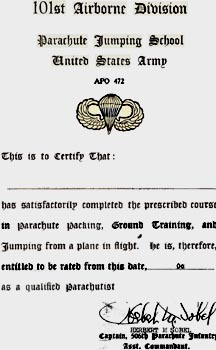 This graduation certificate from the 101st Airborne's Chilton Foliat Parachute Jumping School, was awarded to the late T/5 Don Peterson of B/326th AEB. You will note that it was signed by the commandant of that school in late 1944, the famous Captain Herbert Sobel, former E/506th C.O. Although not visible in the scan, this certificate is dated 13 Oct 44. courtesy D. Peterson
This graduation certificate from the 101st Airborne's Chilton Foliat Parachute Jumping School, was awarded to the late T/5 Don Peterson of B/326th AEB. You will note that it was signed by the commandant of that school in late 1944, the famous Captain Herbert Sobel, former E/506th C.O. Although not visible in the scan, this certificate is dated 13 Oct 44. courtesy D. Peterson














